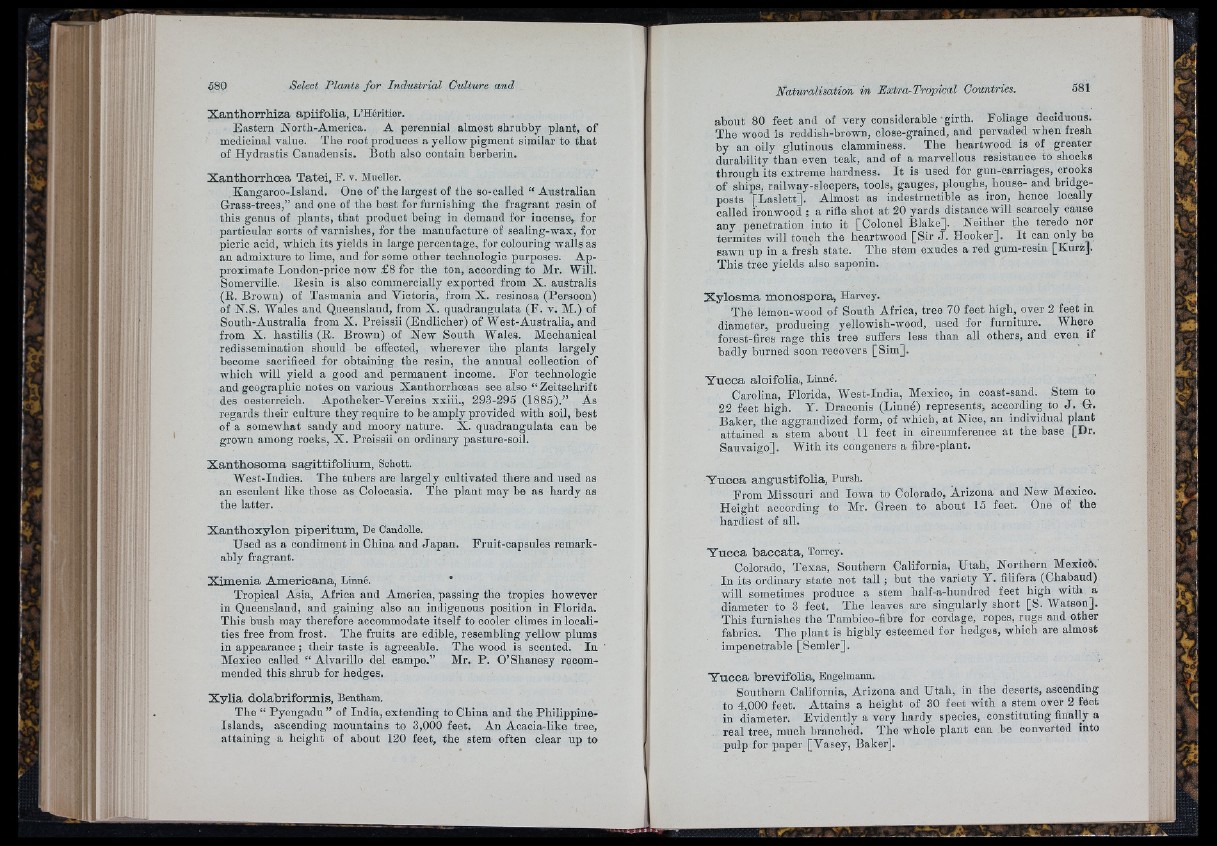
Xanthorrhiza apiifoha, L’Héritier.
Eastern North-America. A perennial almost shruhby plant, of
medicinal value. The root produces a yellow pigment similar to th a t
of Hydrastis Canadensis. Both also contain berherin.
Xanthorrhoea Tatei, F. v. Mueller.
Kangaroo-Island. Cne of the largest of the so-called “ Australian
Grass-trees,” and one of the best for furnishing the fragrant resin of
this genus of plants, that product being in demand for incense, for
particular sorts of varnishes, for the manufacture of sealing-wax, for
picric acid, which its yields in large percentage, for colouring walls as
an admixture to lime, aud for some other technologic purposes. A p proximate
London-price now £8 for tlie ton, according to Mr. Will.
Somerville. Resin is also commercially exported from X. australis
(R. Brown) of Tasmania and Victoria, from X. resinosa (Persoon)
of N.S. Wales and Queensland, from X. quadraugulata (F . v. M.) of
South-Australia from X. Preissii (Endlicher) of West-Australia, and
from X. hastilis (R. Brown) of New South Wales. Mechanical
redissemination should be effected, wherever the plants largely
become sacrificed for obtaining the resin, the annual collection of
which will yield a good and permanent income. For technologic
and geographic notes on various Xauthorrhoeas see also “ Zeitschrift
des Oesterreich. Apotheker-Vereins xxiii., 293-295 (1885).” As
regards their culture they require to be amply provided with soil, best
of a somewhat sandy and moory nature. X. quadrangulata can he
grown among rocks, X . Preissii on ordinary pasture-soil.
Xanthosoma sagittifolium, Schott.
West-Iudies. The tubers are largely cultivated there and used as
an esculent like those as Colocasia. The plant may be as hardy as
the latter.
Xanthoxylon piperitum, De Candolle.
Used as a condiment in China and Japan,
ably fragrant.
Fruit-oapsules remark-
Ximenia Americana, Linné.
Tropical Asia, Africa and America, passing the tropics however
in Queensland, and gaining also an indigenous position in Florida.
This bush may therefore accommodate itself to cooler climes in localities
free from frost. The fruits are edible, resembling yellow plums
in appearance ; their taste is agreeable. The wood is scented. In
Mexico called “ Alvarillo del campo.” Mr. P . O’Shanesy recommended
this shrub for hedges.
Xylia dolabriformis, Bentham.
The “ Pyengadu ” of India, extending to China and the Philippine-
Islands, ascending mountains to 3,000 feet. An Acacia-like tree,
attaining a height of ahout 120 feet, the stem often clear up to
about 80 feet and of v e r y considerable-girth. Foliage deciduous.
The wood is reddish-brown, close-grained, and pervaded when fresh
by an oily glutinous clamminess. The heartwood is of greater
durability than even teak, and of a marvellous resistance to shocks
through its extreme hardness. I t is used for gun-carriages, crooks
of ships, railway-sleepers, tools, gauges, ploughs, house- and bridge-
posts [L a sle tt]. Almost as indestructible as iron, hence locally
called ironwopd ; a rifle shot a t 20 yards distance will scarcely cause
any penetration into it [Colonel Blake]. Neither the teredo nor
termites will touch the heartwood [Sir J . Hooker]. I t can only be
sawn up in a fresh state. The stem exudes a red gum-resin [Kurz].
This tree yields also saponin.
Xylosma monospora, Harvey.
The lemon-wood of South Africa, tree 70 feet high, over 2 feet in
diameter, producing yellowish-wood, used for furniture. Where
forest-fires rage this tree suffers less than all others, and even if
badly burned soon recovers [Sim].
Yucca aloifolia, Linné.
Carolina, Florida, West-India, Mexico, in coast-sand. Stem to
22 feet high. Y. Draconis (Linné) represents, according to J . G.
Baker, the aggrandized form, of which, at Nice, an individual plant
attained a stem about 11 feet in circumference a t the base [Dr.
Sauvaigo]. With its congeners a fibre-plant.
Yucca angustifolia, Pursh.
From Missouri and Iowa to Colorado, Arizona and New Mexico.
Height according to Mr. Green to about 15 feet. One of the
hardiest of all.
Yucca baccata, Torrey.
Colorado, Texas, Southern California, Utah, Northern Mexico.'
In its ordinary state not tall ; hut the variety Y. filifera (Chabaud)
will sometimes produce a stem half-a-hundred feet high with a
diameter to 3 feet. The leaves are singularly short [S. Watson].
This furnishes the Tambico-fibre for cordage, ropes, rugs and other
fabrics. The plant is highly esteemed for hedges, which are almost
impenetrable [Semler].
Y uc ca brevifoUa, Engelmann.
Southern California, Arizona and Utah, in the deserts, ascending
to 4,000 feet. Attains a height of 30 feet with a stem over 2 feet
in diameter. Evidently a very hardy species, constituting finally a
real tree, much branched. The whole plant can be converted into
pulp for paper [Vasey, Baker].